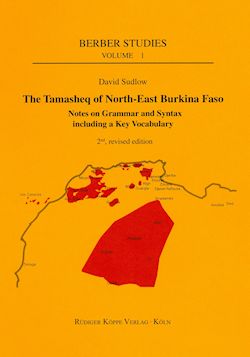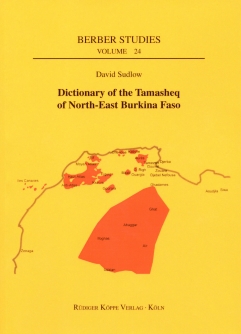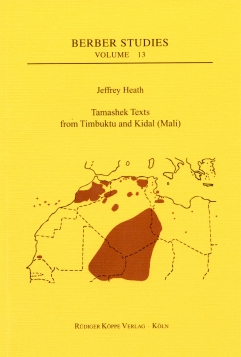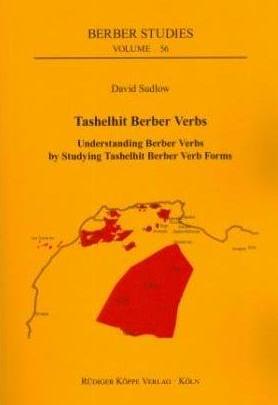



The Tamasheq of North-East Burkina Faso – a Learner's Grammar
Notes on Grammar and Syntax including a Key Vocabulary
Author: David Sudlow. Series edited by: Harry Stroomer.
Series: BS Berber Studies Volume 1
201112 pp. Roman, 340 pp.
2., completely revised edition
1 map, numerous tables and charts, appendix: overview of dialects
Text language(s): English
E-book
€ 69.80
Buy 'The Tamasheq of North-East Burkina Faso – a Learner's Grammar' as a downloadable PDF document directly from our online shop »
Tamasheq is the language spoken by the Tamasheq people, descendants of Berber traders and warriors who traversed the Sahara and settled along the routes and the lands beyond, and the black African peoples enslaved by these raiding warriors. The language therefore closely resembles the Berber languages of the Maghreb instead of the neighbouring sub-Saharan African languages. It is estimated that there are between one and two million speakers of Tamasheq, found mainly in Algeria, Mali, Niger and Burkina Faso but spreading into Libya, Mauritania and Morocco. Among the Berber languages Tamasheq represents presumably the language still the least influenced by contact with Arabic or other languages, although most of the Tamasheq people today are at least bilingual.
This second edition of the learner's grammar The Tamasheq of North-East Burkina Faso is based on data gathered between February 1994 and February 2007 in Oudalan province, Burkina Faso, where the vast majority of Burkinabé Tamasheqs are found. The author was resident in Gorom-Gorom for the first two years and later in Markoye. He also visited camps and villages throughout the Tamasheq speaking areas, notably Beyga, Darkoye, Zigeberi and Tin-Akof. The two dialects of Tamasheq spoken in Burkina are covered in the main sections of the Grammar while comparisons with the dialects of Mali and Niger are made in the first appendix.
The grammar fills a gap in the current literature in two key ways. Firstly it describes in detail the Tamasheq dialects of Burkina which have not previously been studied. Secondly it describes all aspects of the grammar in a relatively non-technical style with a view to pedagogical usefulness. The grammar comprises five main sections: Firstly an introduction which gives background information on the history and language of the Tamasheq in general. Secondly a set of introductory texts that give a selection of key phrases in the language. The third section gives a comprehensive overview of the grammar of the language complete with detailed examples. The fourth section deals with the complex verb system, providing a simplified structure and listings of verbs according to their type.
Section five is a key vocabulary listing important words by theme and includes chapters on idiomatic phrases and proverbs. The first appendix provides an overview of the differences between the Burkina dialects and other Sahelian dialects of Tamasheq, while the second appendix is a short bibliography.
Under these links you will find a Tamasheq-English dictionary and text collections. Furthermore, an analysis of the Tashelhiyt Berber verbs has been published, as well as an elementary course of Taschelhit and of an Algerian Tuareg language (Tahaggart):
Accompanying material:
- Dictionary of the Tamasheq of North-East Burkina Faso
(ISBN 978-3-89645-924-4 ) - Tamashek Texts from Timbuktu and Kidal (Mali)
(ISBN 978-3-89645-392-1 )
Cross-reference:
- Taschelhit
(ISBN 978-3-89645-589-5 ) - Tashelhiyt Berber Verbs
(ISBN 978-3-89645-956-5 ) - Tuareg Elementary Course (Tahaggart)
(ISBN 978-3-89645-929-9 )
Reviews
The new Rüdiger Köppe series Berber Studies starts with a remarkable volume. David Sudlow, a member of the Summer Institute of Linguistics, presents us with a grammatical sketch with dialogues and vocabulary of the southernmost Berber varieties, the Tuareg of Burkina Faso. This is the first linguistic work on these dialects. [...]
David Sudlow's book constitutes an important contribution to Tuareg dialectology and to Berberology in general. Grammatical description may not always be very profound, but is illuminated by well-chosen examples. Tuareg forms are remarkably well transcribed, and every page attests to Sudlow's intimate knowledge of the language. We must be grateful to the author that due to his work we are now so much better informed on these fascinating dialects.
Maarten Kossmann in Journal of African Languages and Linguistics, 25/1, 2001, 89-92
| « back | Print version | [top] |
 Books
Books Audio
Audio Biographies
Biographies Series
Series Festschrifts
Festschrifts Journals
Journals